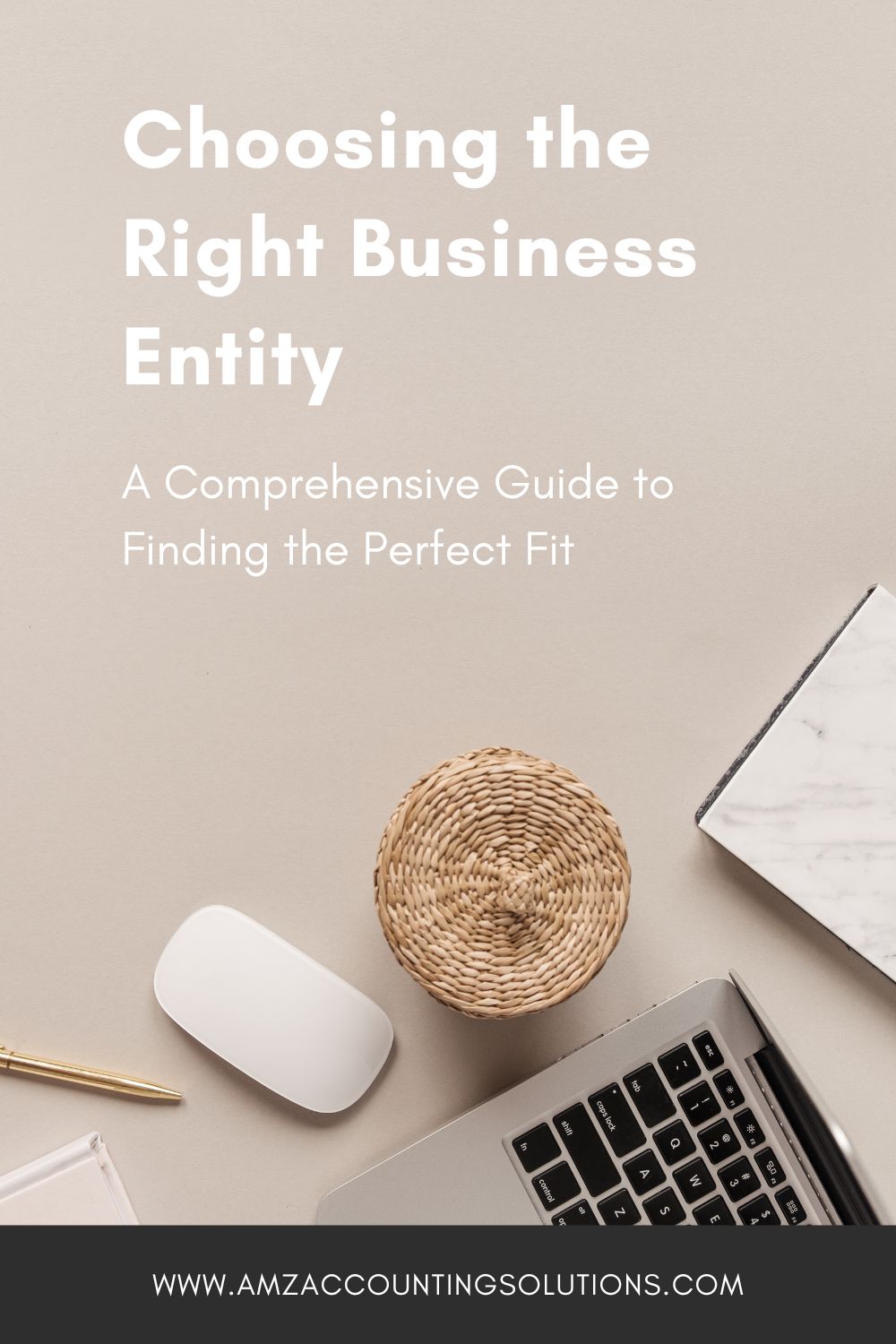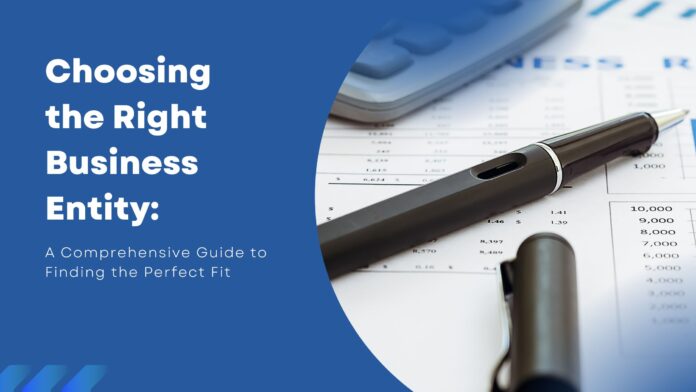Introduction
When starting a new business, selecting the right business legal structure is crucial to the long-term growth and success of your enterprise. Your choice of entity type will affect everything from taxes to personal liability, and it can be challenging to determine which one is the best for your business.
In this article, we will examine various types of business structures and evaluate their advantages and disadvantages, as well as their impact on tax burden. The first step in selecting the right business entity type is understanding what each structure offers.
Sole proprietorships are popular because they are easy to set up and maintain, but they also expose owners to unlimited personal liability for any debts or legal issues that may arise. Partnerships, on the other hand, are an appealing option for businesses with multiple owners who share in profits and losses alike.
However, partnerships have their own unique risks concerning tax burdens and legal liability. Limited Liability Companies (LLCs) offer more flexibility than either sole proprietorships or partnerships by separating personal assets from business assets while still allowing pass-through taxation benefits.
S Corporations are another option worth considering for small businesses that want protection from lawsuits but don’t want to sacrifice flexibility or incur double taxation. C Corporations offer robust protections against personal liabilities while also providing favorable tax treatment under certain circumstances.
Choosing the right entity type requires evaluating your specific needs based on factors such as the size of your operation and industry requirements. To make an informed decision about which one is right for you, it’s important to carefully consider the advantages and disadvantages of each option while bearing in mind how they might impact your long-term goals concerning both legal protection and tax burden management.

Decoding Business Structures
When starting a business, one of the most important decisions you will make is selecting an appropriate business legal structure that aligns with your goals and objectives.
The business legal structure you choose determines the tax burden, personal liability, and management structure of your enterprise. Therefore, it is critical to understand the various types of business structures available before deciding which one is best suited for your venture.
The various types of entities include sole proprietorship, partnership, limited liability company (LLC), S corporation (S Corp), and C corporation (C Corp). Each of these structures has its unique advantages and disadvantages.
It’s essential to evaluate each option carefully and understand how they fit into your overall business strategy. In addition to these structures’ legal implications, it’s crucial to consider factors such as taxation, operational flexibility, ownership continuity, ease of formation, and compliance requirements when weighing your options.
Exploring Various Types of Business Structures
When it comes to exploring the various types of business structures, entrepreneurs have several options to choose from. Each structure has its unique advantages and disadvantages concerning ownership, liability, management control, and tax implications. The first business legal structure is Sole Proprietorship.
This type of business is the simplest form of ownership in which an individual owns and operates the company. Sole proprietorship offers many advantages, including flexibility in decision-making, no additional tax burden on the business’s income, and easy dissolution of the company when desired.
On the downside, a sole proprietor is personally liable for all debts and obligations incurred by their business. This means that if their company goes bankrupt or faces a lawsuit, creditors can come after their personal assets to pay off outstanding debts.
The second type is Partnership. A partnership involves two or more individuals who share management responsibilities for a company’s operations and profit distribution.
Similar to sole proprietorship, partnerships have no additional tax burden on their income as they are considered “pass-through” entities for tax purposes. However, partners in a partnership are jointly liable for all obligations incurred by the business.
This means that each partner is responsible for paying off any debts accrued by the other partner(s). Additionally, disagreements between partners can lead to conflicts over decision-making control and potentially lead to disputes that could threaten the success of the partnership altogether.

Unpacking Sole Proprietorship
A sole proprietorship is often the simplest form of business legal structure as it involves a single owner who has complete control over the operations of the company. In this setup, the business is seen as an extension of the owner, and therefore, there are no legal distinctions between the two. One of the significant advantages of a sole proprietorship is that they have minimal startup costs and do not require extensive paperwork to get started.
However, it’s essential to consider some disadvantages before opting for this type of entity. A significant drawback, in this case, is that since there’s no separation between personal and business finances, all debts and tax burdens fall on the owner.
This means that if your business runs into financial trouble or legal problems, creditors can come after your personal assets, such as your home or car, to recover their money. Thus, it’s critical to ensure you have adequate liability insurance coverage when running a sole proprietorship to protect yourself from such risks.
Another aspect to consider when choosing a sole proprietorship is its tax implications. Since you are considered self-employed under this setup, you will be required to pay self-employment taxes on top of income taxes.
These taxes can be quite complicated to calculate and may involve paying estimated taxes quarterly throughout the year. However, unlike other entities such as corporations or LLCs, where owners need to file separate returns for their businesses, with a sole proprietorship, you’ll only need to include your profits or losses on your personal income tax return.
Diving into Partnerships
Partnerships are a popular option for entrepreneurs who want to work with others to start and run a business. A partnership is created when two or more people come together to carry on a trade or business as co-owners. There are two main types of partnerships: general partnerships and limited partnerships.
In a general partnership, all partners have the authority to act on behalf of the business and share in the profits and losses equally. In a limited partnership, there are one or more general partners who manage the business and are personally liable for its debts, while the limited partners contribute capital but do not participate in management.
One advantage of partnerships is that they offer flexibility in terms of management and ownership structure. Partnerships can be created through oral agreement, written agreement, or even by implication when people act as if they have formed a partnership.
However, it is important to have a formal written agreement that spells out each partner’s responsibilities, the share of profits/losses, decision-making authority, dispute resolution process, and other important provisions. It is also important to consider the tax implications of forming a partnership because it is considered a pass-through entity for tax purposes.
This means that profits and losses flow through to each partner’s personal tax return based on their share of ownership in the business’s legal structure. Therefore, it is essential for partners to agree on how income will be distributed among them and how much each partner will pay in taxes before forming a new venture.

Limited Liability Company (LLC) Uncovered
Limited Liability Company (LLC) is a popular business legal structure that combines the benefits of partnerships and corporations. As an LLC owner, you can enjoy the flexibility of a partnership while enjoying limited liability protection like a corporation.
This means your personal assets are protected in case of lawsuits or creditors come after your business debts. Additionally, LLCs are not taxed as a separate entity, which translates to lower tax burdens.
One significant benefit of forming an LLC is its flexible management structure. Unlike corporations, LLC owners can choose to manage their businesses themselves or elect someone else to take charge.
This can be an attractive attribute for new and small businesses that don’t have many stakeholders and do not want complex corporate structures. Additionally, because there is no requirement for an annual shareholder meeting or board of directors meetings as with corporations, it minimizes paperwork and compliance requirements for business owners.
Another advantage of forming an LLC is pass-through taxation. The profit or loss generated by the business “passes through” to the owners’ individual tax returns based on their percentage ownership share in the company.
This means that LLC members only pay taxes once on income generated by the company instead of twice at both the corporate and individual levels, as with C corporations. Furthermore, certain tax deductions are available to members, such as self-employment taxes on earnings and operating expenses incurred during daily operations allowed through federal tax laws for sole proprietors and partnerships.
Another advantage of an LLC is that it has the flexibility to choose how it wants to be taxed – it can be a sole proprietorship, a partnership, an S corporation, or a C corporation.
S Corporation: A Closer Look
S Corporations, or S Corps, have gained popularity among small business owners due to their flexibility in terms of taxation and management. An S Corp is a type of corporation that meets specific Internal Revenue Service (IRS) requirements and elects to be taxed as a pass-through entity. This means that the company’s profits, losses, deductions, and credits pass through to the shareholders’ personal tax returns.
One key advantage of an S Corp is that it eliminates the double taxation experienced by C Corporations. In a C Corporation, the company’s profits are first taxed at the corporate level before being distributed as dividends to shareholders, who then pay personal income tax on those dividends.
With an S Corp, there is no double taxation because profits are only taxed once at the individual shareholder level. Moreover, S Corps offer limited liability protection like C Corporations while avoiding excessive paperwork and formalities required of other business legal structures.
Another advantage of an S Corp is how it can be structured for more effective business management. Unlike LLCs or partnerships, where ownership interests are tied to capital contributions made by each partner or member respectively, shares in an S Corp can be divided up according to different criteria, such as voting rights or profit entitlements.
This can help ensure that key decisions are made by those with a vested interest in the success of the company rather than simply by financial contributions made by investors. However, it’s important for business owners considering this option to consult with legal counsel before deciding whether or not this structure suits their needs since there may be certain restrictions on who can hold shares in an S Corporation.

C Corporation: An In-depth Analysis
One of the most common legal structures for businesses in the United States is the C corporation. A C corporation is a separate legal entity from its owners, which means that it can conduct business, enter into contracts, and sue or be sued in its own name. Additionally, shareholders are not personally liable for the debts or obligations of the business.
This can provide a significant level of protection to individual investors and may make it easier to raise capital. C corporations are also known for offering a wide range of tax benefits.
For example, they have access to more deductions than most other types of businesses, including those related to employee benefits and retirement plans. Additionally, C corporations are subject to what’s known as an “entity-level tax,” which means that profits are taxed at the corporate level before being distributed as dividends to shareholders.
This can help reduce individual tax liability for investors since they are only taxed on their share of distributed profits rather than on all corporate income. It’s important to note that this can be an advantage if you plan on reinvesting much of your company’s earnings into growth initiatives rather than distributing them as dividends.
Guidelines for Selecting the Optimal Business Structure
Selecting the appropriate legal structure is a crucial decision for any business owner. There are several factors to consider when determining which structure will best suit your needs, including tax implications, legal liabilities, and management requirements. To simplify the process of selecting an entity type, there are some guidelines that you can use to help you make the right decision.
Firstly, it is essential to consider the tax burden of each entity type. Each business legal structure has unique tax implications that can impact your bottom line significantly.
For example, sole proprietorships and partnerships generally have lower taxes than corporations. With LLCs, S Corporations, and C Corporations, you may pay higher taxes but also get additional benefits such as stock shares or liability protection.
Consulting a financial advisor or accountant may be necessary to determine the optimal choice for your situation’s specific tax requirements.
Secondly, it’s essential to look at the business legal structure’s management requirements before making a final decision.
If you prefer to have more control over your company’s operations and decision-making processes, then running as a sole proprietorship or partnership could be ideal for you. On the other hand, if you want specialized roles or even investors in your company and delegate some responsibilities outside of ownership in exchange for protection, then LLCs (Limited Liability Companies), S Corporations, and C Corporations are ideal choices.
Selecting an appropriate business legal structure can appear daunting, but with these guidelines in mind, one can make an informed choice about what type will work best, given their needs. By considering factors such as tax implications and management requirements early on in the process of deciding which entity type is right for them, entrepreneurs can ensure they’ll choose wisely and avoid any issues down the road regarding their business entity structure!
Conclusion
Selecting the right business legal structure is crucial to the success and growth of your business. Depending on the nature, size, and scope of your business, each entity type has its own advantages and disadvantages. However, the most important factor to consider when selecting an entity is how it impacts your tax burden.
Sole proprietorships are ideal for small businesses with low-risk exposure, while partnerships are better suited for businesses that require multiple owners. LLCs provide a balance between flexibility in management and protection from personal liability while S corporations have tax benefits, and C corporations are best suited for large-scale companies with many shareholders.
When selecting an entity type, it’s important to consult with a tax professional or attorney to ensure that you understand how each structure impacts your tax liabilities. It’s also important to carefully weigh the pros and cons of each entity type before making a decision.
Ultimately, choosing an optimal legal business structure will help you protect your personal assets, minimize taxes and set yourself up for long-term success in your industry. By taking the time to select an appropriate business structure, you’ll be well on your way to establishing a strong foundation for growth in your entrepreneurial journey.
Unraveling the complexities of business entities is only the start of your journey into financial optimization. Take your insights a step further by exploring how Accountable plans as a tax strategy for small business owners can save you thousands or delve into the potential goldmine hidden within Real estate opportunity zones. Don’t miss these chances to maximize your profits and harness the full potential of your business.

Frequently Asked Questions
Q: What are the different types of business entities?
A: In the USA, the most common types of business entities are Sole Proprietorship, Partnership (which can be General or Limited), Limited Liability Company (LLC), and Corporation (which can be C Corporation or S Corporation). Less common are Cooperative, Nonprofit Organizations, and Limited Liability Partnerships (LLP).
Q: How does the selection of a business entity impact the taxation of my business?
A: Different business entities are taxed differently. Sole proprietorships, partnerships, and LLCs are “pass-through” entities, meaning the business’s income is reported on the owners’ personal tax returns. C Corporations are subject to “double taxation,” where the corporation pays taxes on its earnings, and shareholders also pay taxes on dividends. S Corporations, like pass-through entities, have their income, losses, deductions, and credits passed to their shareholders for federal tax purposes.
Q: What is a sole proprietorship, and when is it a good choice for my business?
A: A Sole Proprietorship is a type of business entity that is owned and run by one individual. It is the simplest and least expensive business structure to establish. The owner has complete control over the business. However, the owner is personally responsible for all the business’s debts. It’s a good choice when you’re starting a low-risk business and want to test your business idea before forming a more formal business.
Q: What is a partnership, and how does it work in terms of taxation and liability?
A: A Partnership is a business owned by two or more people who share its profits and losses. A general partnership has partners who all participate in day-to-day operations and who are all personally liable for business debts. Limited partnerships have general partners with unlimited liability and limited partners with liability that’s limited to their investment. For tax purposes, partnerships are pass-through entities.
Q: How does a Limited Liability Company (LLC) protect me from personal liability?
A: An LLC provides its owners (members) with limited liability for the business’s debts and obligations. This means that the personal assets of the LLC members cannot typically be seized to pay for the business’s debts. This is different from a sole proprietorship or a general partnership, where the owners have unlimited personal liability for the business’s debts.
Q: What is a C Corporation, and what are its advantages and disadvantages?
A: A C Corporation is a legal entity that is separate from its owners, the shareholders. It can make a profit, be taxed, and can be held legally liable. The advantages of a C Corporation include limited liability for shareholders, no limit on the number of shareholders, and potential tax advantages (like being able to deduct the cost of benefits provided to employees). The disadvantages include double taxation (profits are taxed at the corporate level, and dividends are taxed at the individual level), and they are more expensive and complex to set up and run than other business structures.
Q: What is an S Corporation, and how does it differ from a C Corporation?
A: An S Corporation is a special type of corporation that is designed to avoid the double taxation drawback of regular C Corporations. S Corporations allow profits (and some losses) to be passed through directly to the owners’ personal income without ever being subject to corporate tax rates. However, not all businesses can become an S Corporation. They must meet certain requirements, such as having less than 100 shareholders, and all shareholders must be U.S. citizens or residents.
Q: How does the selection of a business entity affect my ability to raise capital?
A: The structure of your business can significantly impact your ability to raise capital. Corporations, both C and S are usually more attractive to investors. C Corporations can issue several types of stock to raise capital and have an unlimited number of shareholders. S Corporations can only issue one class of stock and are limited to 100 or fewer shareholders. Usually, angel investors and venture capitalists will only consider giving a company funds if it’s structured as a corporation. On the other hand, venture capitalists and sometimes angel investors may not fund LLCs due to the complications they introduce to personal tax situations and restrictions on certain types of investors. Most investors consider investing in sole proprietorships and general partnerships as high-risk due to their lack of liability protection.
Q: What is a nonprofit organization, and when should I consider it as my business entity?
A: A nonprofit organization is a type of business entity that is formed to further a particular social cause or advocate for a shared point of view. Nonprofits are typically funded by donations, grants, and membership dues. If you’re looking to start a business to serve a social or charitable purpose and your primary goal isn’t to make a personal profit, then a nonprofit might be the right choice for you. It’s important to note that nonprofits must follow strict regulations to maintain their tax-exempt status.
Q: Can I change my business entity type later if my business needs to change?
A: Yes, it’s possible to change your business entity type as your business grows and needs change. For example, a sole proprietor might choose to form an LLC or a corporation as the business expands to limit personal liability and attract investors. However, changing your business entity can involve complex legal and tax implications, so it’s advisable to consult with a legal and tax advisor before making such a decision.










